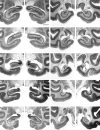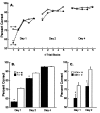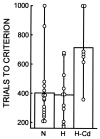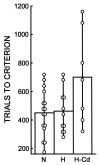Contrasting effects on discrimination learning after hippocampal lesions and conjoint hippocampal-caudate lesions in monkeys
- PMID: 10804225
- PMCID: PMC6772685
- DOI: 10.1523/JNEUROSCI.20-10-03853.2000
Contrasting effects on discrimination learning after hippocampal lesions and conjoint hippocampal-caudate lesions in monkeys
Abstract
Eighteen monkeys with lesions of the hippocampal region (the hippocampus proper, the dentate gyrus, and the subiculum) made by an ischemic procedure, radio frequency, or ibotenic acid were tested on a simple, two-choice object discrimination learning task that has been shown to be sensitive to large lesions of the medial temporal lobe. The monkeys were also tested on two other discrimination tasks (pattern discrimination and eight-pair concurrent discrimination) that can be learned normally by monkeys with large medial temporal lobe lesions. All of the lesion groups were impaired at learning the simple object discrimination task. Seven of the monkeys who had sustained damage to the hippocampal region also sustained damage to the tail of the caudate nucleus. These seven monkeys, but not the other 11 monkeys with hippocampal lesions, were impaired on pattern discrimination and concurrent discrimination learning. The results suggest that the hippocampal region is important for learning easy, two-choice discriminations, whereas the caudate nucleus is necessary for the normal learning of more difficult, gradually acquired discrimination tasks. The findings support the distinction between declarative memory, which depends on the hippocampus and related medial temporal lobe structures, and habit learning, which depends on the caudate nucleus.
Figures




Similar articles
-
Impaired recognition memory in monkeys after damage limited to the hippocampal region.J Neurosci. 2000 Jan 1;20(1):451-63. doi: 10.1523/JNEUROSCI.20-01-00451.2000. J Neurosci. 2000. PMID: 10627621 Free PMC article.
-
Crossed unilateral lesions of temporal lobe structures and cholinergic cell bodies impair visual conditional and object discrimination learning in monkeys.Eur J Neurosci. 2002 Feb;15(3):507-16. doi: 10.1046/j.0953-816x.2001.01888.x. Eur J Neurosci. 2002. PMID: 11876778
-
The effects of fornix transection and combined fornix transection, mammillary body lesions and hippocampal ablations on object-pair association memory in the rhesus monkey.Behav Brain Res. 1989 Nov 1;35(2):85-94. doi: 10.1016/s0166-4328(89)80109-3. Behav Brain Res. 1989. PMID: 2510765
-
Memory and socioemotional behavior in monkeys after hippocampal damage incurred in infancy or in adulthood.Biol Psychiatry. 1999 Aug 1;46(3):329-39. doi: 10.1016/s0006-3223(99)00123-7. Biol Psychiatry. 1999. PMID: 10435198 Review.
-
On the role of the hippocampus in learning and memory in the rat.Behav Neural Biol. 1993 Jul;60(1):9-26. doi: 10.1016/0163-1047(93)90664-4. Behav Neural Biol. 1993. PMID: 8216164 Review.
Cited by
-
Neurobiological substrates of animal personality and cognition in a nonhuman primate (Microcebus murinus).Brain Behav. 2020 Sep;10(9):e01752. doi: 10.1002/brb3.1752. Epub 2020 Jul 18. Brain Behav. 2020. PMID: 32683780 Free PMC article.
-
The Role of Habits in Anorexia Nervosa: Where We Are and Where to Go From Here?Curr Psychiatry Rep. 2018 Jul 23;20(8):61. doi: 10.1007/s11920-018-0928-5. Curr Psychiatry Rep. 2018. PMID: 30039342 Free PMC article. Review.
-
There Is More Than One Kind of Extinction Learning.Front Syst Neurosci. 2019 May 7;13:16. doi: 10.3389/fnsys.2019.00016. eCollection 2019. Front Syst Neurosci. 2019. PMID: 31133825 Free PMC article.
-
How do the basal ganglia contribute to categorization? Their roles in generalization, response selection, and learning via feedback.Neurosci Biobehav Rev. 2008;32(2):265-78. doi: 10.1016/j.neubiorev.2007.07.010. Epub 2007 Aug 12. Neurosci Biobehav Rev. 2008. PMID: 17919725 Free PMC article. Review.
-
Rats depend on habit memory for discrimination learning and retention.Learn Mem. 2007 Mar 8;14(3):145-51. doi: 10.1101/lm.455607. Print 2007 Mar. Learn Mem. 2007. PMID: 17351137 Free PMC article.
References
-
- Baxter MG, Hadfield WS, Murray EA. Rhinal cortex lesions produce mild deficits in visual discrimination learning for an auditory secondary reinforcer in rhesus monkeys. Behav Neurosci. 1999;113:243–252. - PubMed
-
- Buffalo EA, Stefanacci L, Squire LR, Zola SM. A reexamination of the concurrent discrimination learning task: the importance of inferotemporal cortex, area TE. Behav Neurosci. 1998;112:3–14. - PubMed
-
- Dean P. Effects of inferotemporal lesions on the behavior of monkeys. Psychol Bull. 1976;83:41–71. - PubMed
Publication types
MeSH terms
Substances
Grants and funding
LinkOut - more resources
Full Text Sources
Other Literature Sources
